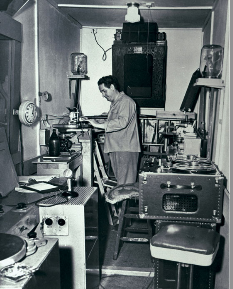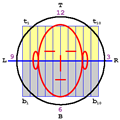Hey folks,
Im just finding my way around Notion 4 and its awesome and a full orch template runs very smoothly with the native samples. But I'm fond of my Miroslav Philharmonik and I'm trying to make a template for a full Miro orchestra, but as I cross over the 30 instrument line, Notion crashes on me over and over. Have I opened too many instances of Miro? One posted on here says he make a piece with over 100 instruments (I'm listening to it now, very good) so I feel that can't be it. Any ideas?
I'm also having EWQLSO Gold issues... Who isnt? :/ but i want to get this sorted first. thanks
IMac 27, software and permissions up to date.
- It is currently Tue Jul 01, 2025 9:44 am • All times are UTC - 5 hours [ DST ]
Attention:
Welcome to the old forum. While it is no longer updated, there is a wealth of information here that you may search and learn from.
To partake in the current forum discussion, please visit https://forums.presonus.com
Notion crashes making large Miro score
4 posts
• Page 1 of 1
Re: Notion crashes making large Miro score
wizstudios wrote:Have I opened too many instances of Miro?
Yes . . .
Miroslav Philharmonik (IK Multimedia) is a 32-bit VSTi virtual instrument, and it only works with the 32-bit version of NOTION 4, as you know, since you had to check the "Open in 32-bit mode" option in "Get Info . . . " for "Notion.app", hence (a) the 32-bit application workspace limitation (4GB) applies and (b) based on my experience the general rule that I developed starting with NOTION 3, which was 32-bit only, is that a score can handle 20 to 25 VSTi virtual instruments with no problems, but problems begin occurring soon thereafter due to the 32-bit application workspace limitation, which also applies to the 32-bit version of NOTION 4 . . .
With Miroslav Philharmonik there are strategies that can make it a bit better, since you can have up to 16 articulations for a single Miroslav Philharmonik VSTi instrument, where the general rule is one VSTi instrument per staff in NOTION 3 and NOTION 4, which applies to everything, not just Miroslav Philharmonik . . .
[NOTE: It also depends on what one counts as a "VSTi virtual instrument instance", where for example if you have a single Miroslav Philharmonik staff and have the ensemble of 23 violins selected, then you could count it as 23 violins, but it is just one VSTi virtual instrument instance . . . ]
The significant difference is that NOTION 3 had predefined definitions and rules for Miroslav Philharmonik, which were done by Notion Music and were designed specifically to be optimal for use with NOTION 3, and this probably is the way folks were able to create NOTION 3 scores with a lot of Miroslav Philharmonik instruments, but when I switch to the 32-bit version of NOTION 4, I am not seeing the specially defined Miroslav Philharmonik instruments in Score Setup. Instead, I only see the basic VSTi selection, and as noted (see above), when one uses the basic VSTi selection, there is a distinct upper limit to what NOTION 3 or NOTION 4 can handle in a 32-bit application workspace . . .
[NOTE: There might be a way to use the predefined NOTION 3 stuff for Miroslav Philharmonik with NOTION 4, but this is a question for Notion Music Technical Support . . . ]
For reference the 20 to 25 practical upper limit for VSTi virtual instruments in NOTION 3 and the 32-bit version of NOTION 4 is not a guarantee, because for example as few as two MachFive 3 (MOTU) staves can overwhelm NOTION 3, and although I have not tested it, this probably happens with the 32-bit version of NOTION 4, as well . . .
The rule I used for MachFive 3 with NOTION 3 was one instance only and no more than 10 other non-MachFIve 3 VSTi virtual instruments, which doing the arithmetic mapped to an upper limit of 11 VSTi virtual instruments per score when one and only one of them is MachFive 3 . . .
In great contrast, I have 64-bit NOTION 4 scores when plenty of MachFive 3 VSTi virtual instruments, all with no problems, but this is using the 64-bit version of MachFive 3, which is entirely different with respect to resource usage, where even when running in 64-bit mode MachFive 3 is a "heavy" virtual instrument, since it has a lot of samples and can do elaborate custom scripting and so forth and so on, but it sounds great, and I like it . . .
On a related note, the high-level strategy I developed for NOTION 3 to get around the 32-bit application workspace limitation involves splitting a score into subscores, where each subscore is a separate NOTION score, and this begins with the first subscore, which is where I determine and specify the overall structure of the song (verse, chorus, bridge, and so forth) and do perhaps 20 of the rhythm section instruments, always including a pair of kick drum and snare drum staves and at least one piano or rhythm guitar track, which I use later for reference points, as well as for the "click track" to establish the beat and tempo for use when I need to record real instruments and singing in the DAW application. Then when I need more instruments I record the existing instruments in the current NOTION subscore as soundbites in Digital Performer (MOTU) via ReWire and clone the original NOTION subscore, giving it a name like "Song-PT-2.notion", where the original subscore was named "Song-PT-1.notion", and I keep all the subscores in a folder for the song on the Mac, so that they are easy to find if I need to change something . . .
[NOTE: The key to this strategy is doing as much advance planning when you are composing, since what you are doing is creating a song in layers, which is the way Phil Spector created his "Wall of Sound" in the monaural universe of the mid-1950s to early-1960s and is the way George Martin and the audio engineers at Abbey Road Studios created the unique Beatles sound, all of which traces back to Les Paul originating the technique using a one-track Ampex analog magnetic tape recorder that Bing Crosby gave him and which Les Paul modified by adding a second playback head, thereby creating "sound on sound" recording . . . ]

Les Paul's Studio ~ Late-1940s or Early-1950s
[SOURCE: CLASSIC TRACKS: Les Paul & Mary Ford "How High The Moon" (Sound on Sound)]
Over time, I might have 10 or 20 of these cloned subscores, where each one typically has 10 to 15 new instruments but also has 5 common instruments, where once I compose the melody I use it as a common staff instead of one of the kick drum staves, and I do this make it easy to keep track of sections and parts of the song, so that later for example if I want to add a trombone phrase at the start of the third verse, thenI can find the correct location by listening to or looking at the rhythm guitar chords, melody, bass part, or whatever, and doing it this way makes it both possible and practical do a song that has 500 to 1,000 instruments, which is important because I like to "sparkle" instruments, which is the name of the technique I developed to put the notes of a single instrument into motion across the "rainbow panning arc", which I do via eight staves of the same instrument, where each staff in the set is panned to a different location, hence if I want a note for the instrument to be heard at far-left, then I put the note on the staff that is panned to the far-left, but if I want a note to be heard at top-center, I put the note on the staff that is panned to top-center, and so forth, where it usually takes an hour or two to put the notes on the different staves, which might appear to be a lot of work, except (a) it is very precise; (b) there is no easier way to do it with such absolute precision; and (c) it is a lot faster than trying to play it one note at a time using a real instrument in a DAW application . . .
[NOTE: This is an example of a "sparkled" Psaltery Harp, which is accompanied by a Tormented Bass, with these being IK Multimedia VSTi virtual instruments from the Xpansion Tank 2 World Instruments Collection and Sonik Synth 2, as I recall. It is easier to hear the sonic motion if you listen with headphones, but it also is heard when you listen with studio monitors. "Sparkling" is possible and practical in NOTION, because NOTION 3 and NOTION 4 have true stereo panning controls, which are virtually mind-boggling, where for reference a monaural track in a typical DAW application has a true panning control, but for a stereo track a typical DAW application "panning" control actually is a balance control, which is entirely different, since a stereo balance control only controls the relative volume of the left and right channels and does not move left-channel stuff to the right-channel and vice-versa. With a true stereo panning control you can move the audio material across the "rainbow panning arc", and if you use two stereo tracks for each instrument, then you can do even more stuff once you get the NOTION 4 generated audio into the DAW application . . . ]
"Sparkles" (The Surf Whammys) -- MP3
THOUGHTS
I am a huge fan of IK Multimedia VSTi virtual instruments, but at present they are 32-bit only, which is somewhat annoying, so I am using the time to have a bit of FUN with 64-bit VSTi virtual instruments like Addictive Drums and Addictive Keys (XLN Audio), Cyclop (Sugar Bytes), Kontakt 5 (Native Instruments), MachFive 3 (MOTU), and Twin 2 (FabFilter Software Instruments), as well as Reason 6.5 (Propellerhead Software) which is not a VSTi virtual instrument but can be controlled and played using music notation on NOTION 4 External MIDI staves as well as by ReWire 2 . . .
IK Multimedia has stated that the 64-bit versions of their virtual instruments will be released this year (2013), and this certainly is my expectation, but all I can do is guess since I have no insider information, and at present my best guess is that it probably is not going to be in the first half of the year, really . . .
Really!
P. S. I do everything on the 2.8-GHz 8-core Mac Pro (early-2008) with 20GB of memory here in the sound isolation studio, and the 64-bit version of NOTION 4 and everything else has plenty of headroom and application workspace, which is stellar!
-

Surfwhammy - Posts: 1137
- Joined: Thu Oct 14, 2010 4:45 am
Re: Notion crashes making large Miro score
Thanks. So it's a 32 bit problem. Ok. I'd work in EWQLSO but I'm having trouble loading all the samples (piccolo yes, flutes no, clarinets no, 3 clarinets yes, oboe yes, timp no etc.) which I'm currently working with Brian to sort out. IK told me the same thing, that ST3 is on the way, will be 64bit and will update Miro, thank god. let's hope the upgrade path isn't too expensive.
-

wizstudios - Posts: 16
- Joined: Sun May 19, 2013 7:45 pm
Re: Notion crashes making large Miro score
I use Miroslav and Surfwhammy of course has it right. Here are some things I have found that help.
You didn't say if you have a 64-bit OS and can run the 64-bit version of Notion. If so, you can try using jBridge. 32-bit Windows has a limit of 2GB of RAM for a process. In terms of 32-bit Notion, that is 2GB for both Notion and whatever VSTis are loaded. I easily can push the 2GB limit with several instances of Miroslav. Using jBridge I can run Miroslav in 64-bit Notion. Since we are now running a 64-bit process, the 2GB RAM limit no longer applies . I haven't tried this, but with jBridge even in a 32-bit host you are supposed to be able exceed the 2GB limit by setting each instance of the VSTi to run in a separate jBridge autohost.exe. If you have 32-bit Windows, you are still subject to a limitation of 4GB (actually 3.5GB) RAM no matter how much RAM is installed.
. I haven't tried this, but with jBridge even in a 32-bit host you are supposed to be able exceed the 2GB limit by setting each instance of the VSTi to run in a separate jBridge autohost.exe. If you have 32-bit Windows, you are still subject to a limitation of 4GB (actually 3.5GB) RAM no matter how much RAM is installed.
Another thing I do is to use section presets. That way I can use 1 instance of the VSTi to serve up several sections. For example, Viola, Cello and Bass may be in one VSTi instance. There is a very good set of Miroslav templates and presets uploaded by elerouxx:
http://forum.notionmusic.com/viewtopic.php?f=24&t=1803
I haven't anywhere near having 100 VSTis loaded but I can get a full orchestra by using jBridge and section presets for Strings and Brass.
- Dave
You didn't say if you have a 64-bit OS and can run the 64-bit version of Notion. If so, you can try using jBridge. 32-bit Windows has a limit of 2GB of RAM for a process. In terms of 32-bit Notion, that is 2GB for both Notion and whatever VSTis are loaded. I easily can push the 2GB limit with several instances of Miroslav. Using jBridge I can run Miroslav in 64-bit Notion. Since we are now running a 64-bit process, the 2GB RAM limit no longer applies
Another thing I do is to use section presets. That way I can use 1 instance of the VSTi to serve up several sections. For example, Viola, Cello and Bass may be in one VSTi instance. There is a very good set of Miroslav templates and presets uploaded by elerouxx:
http://forum.notionmusic.com/viewtopic.php?f=24&t=1803
I haven't anywhere near having 100 VSTis loaded but I can get a full orchestra by using jBridge and section presets for Strings and Brass.
- Dave
-

dranck - Posts: 19
- Joined: Mon Apr 08, 2013 7:22 pm
- Location: Sarasota, FL USA
4 posts
• Page 1 of 1
Who is online
Users browsing this forum: No registered users and 32 guests